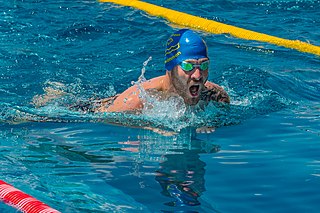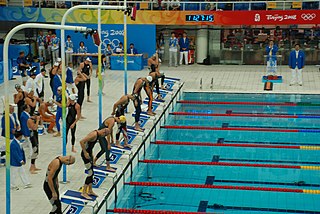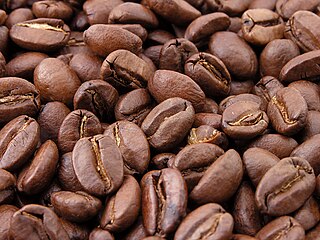Related Research Articles

Running is a method of terrestrial locomotion allowing humans and other animals to move rapidly on foot. Running is a type of gait characterized by an aerial phase in which all feet are above the ground. This is in contrast to walking, where one foot is always in contact with the ground, the legs are kept mostly straight and the center of gravity vaults over the stance leg or legs in an inverted pendulum fashion. A feature of a running body from the viewpoint of spring-mass mechanics is that changes in kinetic and potential energy within a stride co-occur, with energy storage accomplished by springy tendons and passive muscle elasticity. The term running can refer to any of a variety of speeds ranging from jogging to sprinting.

Swimming is the self-propulsion of a person through water, or other liquid, usually for recreation, sport, exercise, or survival. Locomotion is achieved through coordinated movement of the limbs and the body to achieve hydrodynamic thrust that results in directional motion. Humans can hold their breath underwater and undertake rudimentary locomotive swimming within weeks of birth, as a survival response.

A triathlon is an endurance multisport race consisting of swimming, cycling, and running over various distances. Triathletes compete for fastest overall completion time, racing each segment sequentially with the time transitioning between the disciplines included. The word is of Greek origin, from τρεῖς or treis (three) and ἆθλος or athlos (competition).

The marathon is a long-distance foot race with a distance of 42.195 km, usually run as a road race, but the distance can be covered on trail routes. The marathon can be completed by running or with a run/walk strategy. There are also wheelchair divisions. More than 800 marathons are held throughout the world each year, with the vast majority of competitors being recreational athletes, as larger marathons can have tens of thousands of participants.

Long-distance running, or endurance running, is a form of continuous running over distances of at least 3 km (1.9 mi). Physiologically, it is largely aerobic in nature and requires stamina as well as mental strength.

Physical fitness is a state of health and well-being and, more specifically, the ability to perform aspects of sports, occupations and daily activities. Physical fitness is generally achieved through proper nutrition, moderate-vigorous physical exercise, and sufficient rest along with a formal recovery plan.

Altitude training is the practice by some endurance athletes of training for several weeks at high altitude, preferably over 2,400 metres (8,000 ft) above sea level, though more commonly at intermediate altitudes due to the shortage of suitable high-altitude locations. At intermediate altitudes, the air still contains approximately 20.9% oxygen, but the barometric pressure and thus the partial pressure of oxygen is reduced.

Arthur Leslie Lydiard was a New Zealand runner and athletics coach. He has been lauded as one of the outstanding athletics coaches of all time and is credited with popularising the sport of running and making it commonplace across the sporting world. His training methods are based on a strong endurance base and periodisation.
Oligomenorrhea is infrequent menstruation. More strictly, it is menstrual periods occurring at intervals of greater than 35 days, with only four to nine periods in a year. Menstrual periods should have been regularly established before the development of infrequent flow. The duration of such events may vary.
Long slow distance (LSD) is a form of aerobic endurance training used in sports including running, rowing, skiing and cycling. It is also known as aerobic endurance training, base training and Zone 2 training. Physiological adaptations to LSD training include improved cardiovascular function, improved thermoregulatory function, improved mitochondrial energy production, increased oxidative capacity of skeletal muscle, and increased utilization of fat for fuel. Ernst van Aaken, a German physician and coach, is generally recognized as the founder of the LSD method of endurance training.
Periodization is a cyclical method of planning and managing athletic or physical training and involves progressive cycling of various aspects of a training program during a specific period. Conditioning programs can use periodization to break up the training program into the off-season, preseason, inseason, and the postseason. Periodization divides the year round condition program into phases of training which focus on different goals.

Endurance training is the act of exercising to increase endurance. The term endurance training generally refers to training the aerobic system as opposed to the anaerobic system. The need for endurance in sports is often predicated as the need of cardiovascular and simple muscular endurance, but the issue of endurance is far more complex. Endurance can be divided into two categories including: general endurance and specific endurance. It can be shown that endurance in sport is closely tied to the execution of skill and technique. A well conditioned athlete can be defined as, the athlete who executes his or her technique consistently and effectively with the least effort. Key for measuring endurance are heart rate, power in cycling and pace in running.
Peter Dickson Pfitzinger is an American former distance runner, who later became an author and exercise physiologist.
Running economy (RE) measures runners' energy utilization when running at an aerobic intensity, and many physiological and biomechanical factors contribute to it. Oxygen consumption (VO2) is the most commonly used method for measuring running economy, as the exchange of gases in the body, specifically oxygen and carbon dioxide, closely reflects energy metabolism. Those who are able to consume less oxygen while running at a given velocity are said to have a better running economy. However, straightforward oxygen usage does not account for whether the body is metabolising lipids or carbohydrates, which produce different amounts of energy per unit of oxygen; as such, accurate measurements of running economy must use O2 and CO2 data to estimate the calorific content of the substrate that the oxygen is being used to respire.

Swimming is an individual or team racing sport that requires the use of one's entire body to move through water. The sport takes place in pools or open water. Competitive swimming is one of the most popular Olympic sports, with varied distance events in butterfly, backstroke, breaststroke, freestyle, and individual medley. In addition to these individual events, four swimmers can take part in either a freestyle or medley relay. A medley relay consists of four swimmers who will each swim a different stroke, ordered as backstroke, breaststroke, butterfly and freestyle.

In Ancient Greece, the history of running can be traced back to 776 BC. Running was important to members of ancient Greek society, and is consistently highlighted in documents referencing the Olympic Games. The Olympic Games hosted a large variety of running events, each with its own set of rules. The ancient Greeks developed difficult training programs with specialized trainers in preparation for the Games. The training and competitive attitude of Greek athletes gives insight into how scientifically advanced Greece was for the time period.
Hypoventilation training is a physical training method in which periods of exercise with reduced breathing frequency are interspersed with periods with normal breathing. The hypoventilation technique consists of short breath holdings and can be performed in different types of exercise: running, cycling, swimming, rowing, skating, etc.

Competitive cross-country skiing encompasses a variety of race formats and course lengths. Rules of cross-country skiing are sanctioned by the International Ski Federation and by various national organizations. International competitions include the FIS Nordic World Ski Championships, the FIS Cross-Country World Cup, and at the Winter Olympic Games. Such races occur over homologated, groomed courses designed to support classic (in-track) and freestyle events, where the skiers may employ skate skiing. It also encompasses cross-country ski marathon events, sanctioned by the Worldloppet Ski Federation, and cross-country ski orienteering events, sanctioned by the International Orienteering Federation. Related forms of competition are biathlon, where competitors race on cross-country skis and stop to shoot at targets with rifles, and paralympic cross-country skiing that allows athletes with disabilities to compete at cross-country skiing with adaptive equipment.

Caffeine use for sport is a worldwide known and tested idea. Many athletes use caffeine as a legal performance enhancer, as the benefits it provides, both physically and cognitively outweigh the disadvantages. The benefits caffeine provides influences the performance of both endurance athletes and anaerobic athletes. Caffeine has been proven to be effective in enhancing performance. Below is more detail on who benefits more, trained athletes in comparison to untrained, males in comparison to females and aerobic vs anaerobic athletes.

Meenakshi Pahuja is an Indian lecturer and marathon swimmer. After a successful career as a competitive swimmer, she became a teacher at Lady Shri Ram College, and later entered open water swimming. She received a 2018 Nari Shakti Puraskar award.
References
- ↑ Sun Devil Aquatics. "Glossary of Terms". Swim Levels, Meet Types. Archived from the original on 2007-09-28. Retrieved 2007-10-04.
- ↑ Cooper, Bob (2003-12-09). "It's Taper Time". Runner's World. Retrieved 2016-03-06.
- ↑ Pfitzinger, Pete. "Tapering For A Marathon". the Pfitzinger Lab Report. Retrieved 2016-03-06.